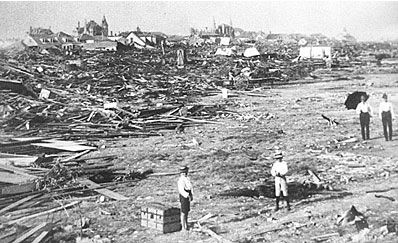Galveston
As a deadly hurricane bears down on the Texas gulf coast, I thought I'd write a requiem post for the 8,000 souls who died in the 1900 storm that devastated Galveston, which was then the fourth-largest city in Texas.
The 1900 storm hit with no advance warning - it was long before satellite tracking, radar, or reliable forecasts (in the absence of professional meteorology, the storm also had no name). Five days after the storm, a Galveston Daily News reporter wrote,
The quote and photograph come from a Galveston Daily News website dedicated to memorializing the 1900 storm.
After the storm, the city participated in a massive effort to raise the elevation of the island's most flood-prone areas, by as much as 16 feet. To me, the raising of Galveston exemplifies Texas's incredible capacity for revival and growth. It was an incredible feat of civic effort and engineering, executed with turn-of-the-century technology.
Entire structures were jacked up into the air and put on stilts:
St. Patrick's Church, Galveston: from the Texas State Library and Archives.
Avenue O residence, Galveston. Note the front stairway suspended in midair. From the Texas State Library and Archives.
Then, massive pipes were laid in the streets, and dredges began to flood the ground beneath the stilts with mud...
Pipelines discharging dredged fountains of muddy fill. From the Texas State Library and Archives.
...until the ground rose up to meet the bottoms of the raised buildings, and the stilts were buried.
Before and after. This photo comes from Pruned.
In the century since, rising seas and geological subsidence have brought Galveston's elevation as much as 2.5 feet closer to sea level. That also brings the city 2.5 critical feet closer to disaster as Hurricane Ike bears down on the barrier island tonight. Worse still, the past few decades have brought intense development of new homes and businesses to the western end of the island, areas unprotected by the city of Galveston's raised grade or seawall.
This storm could be really ugly for southeastern Texas. Let's hope for the best.
The 1900 storm hit with no advance warning - it was long before satellite tracking, radar, or reliable forecasts (in the absence of professional meteorology, the storm also had no name). Five days after the storm, a Galveston Daily News reporter wrote,
The story of Galveston's tragedy can never be written as it is... But in the realm of finity, the weak and staggered senses of mankind may gather fragments of the disaster, and may strive with inevitable incompleteness to convey the merest impression of the saddest story which ever engaged the efforts of a reporter.
The quote and photograph come from a Galveston Daily News website dedicated to memorializing the 1900 storm.
After the storm, the city participated in a massive effort to raise the elevation of the island's most flood-prone areas, by as much as 16 feet. To me, the raising of Galveston exemplifies Texas's incredible capacity for revival and growth. It was an incredible feat of civic effort and engineering, executed with turn-of-the-century technology.
Entire structures were jacked up into the air and put on stilts:
St. Patrick's Church, Galveston: from the Texas State Library and Archives.
Avenue O residence, Galveston. Note the front stairway suspended in midair. From the Texas State Library and Archives.
Then, massive pipes were laid in the streets, and dredges began to flood the ground beneath the stilts with mud...
Pipelines discharging dredged fountains of muddy fill. From the Texas State Library and Archives.
...until the ground rose up to meet the bottoms of the raised buildings, and the stilts were buried.
Before and after. This photo comes from Pruned.
In the century since, rising seas and geological subsidence have brought Galveston's elevation as much as 2.5 feet closer to sea level. That also brings the city 2.5 critical feet closer to disaster as Hurricane Ike bears down on the barrier island tonight. Worse still, the past few decades have brought intense development of new homes and businesses to the western end of the island, areas unprotected by the city of Galveston's raised grade or seawall.
This storm could be really ugly for southeastern Texas. Let's hope for the best.









1 comment:
May God be with all of those who decided to hunker down and stay behind. We pray and cry for the people of Texas.
Post a Comment